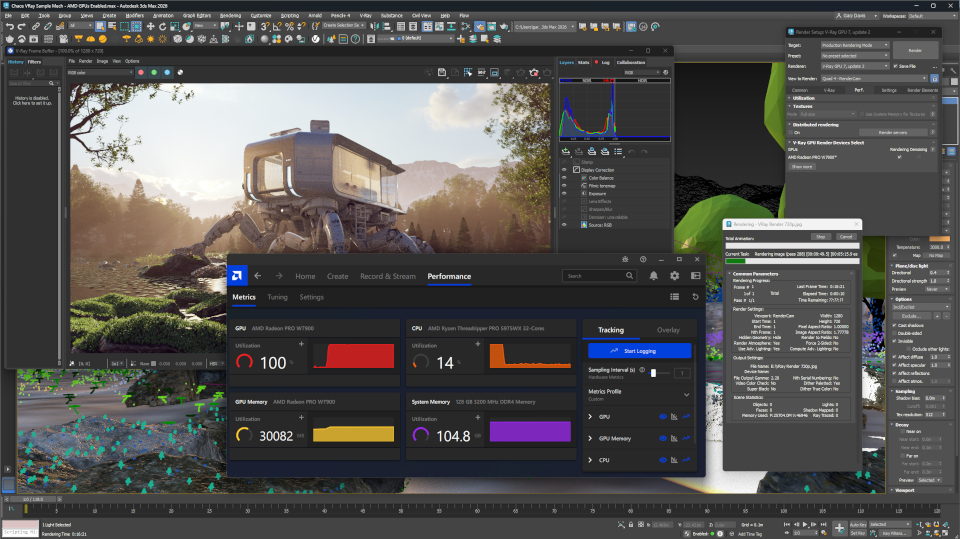Chaos adopts HIP to unleash AMD acceleration in V-Ray GPU

[Sponsored] Discover how Chaos has been able to port the GPU functionality of its industry-leading V-Ray renderer to harness the power of AMD GPUs using the open-source HIP toolkit.
For over 20 years, V-Ray has been an essential part of artists’ toolkits. Chaos’s renderer is currently the one most widely used for architectural visualization according to a recent survey of architectural professionals, and has been used to create VFX for a wide range of commercials, games cinematics, films, and TV shows, including Deadpool, Ant-Man, and Agatha All Along.
V-Ray already performs impeccably on AMD CPUs, but Chaos has now added AMD GPU support. At last month’s AU 2025 conference, Chaos showcased a demo of V-Ray GPU running on an AMD Radeon GPU. When rolled out in a public release, the changes to V-Ray’s code base will give users the freedom to choose a wider range of hardware, such as powerful, affordable AMD Radeon PRO GPUs and AMD Ryzen AI Max+ processors.
How V-Ray harnesses the power of AMD processors
V-Ray provides users with a choice of two render engines. The CPU engine, used for the most demanding tasks, like rendering ultra-high-resolution architectural stills and complex, final-quality visual effects, performs beautifully on AMD processors. As of October 2025, the 10 highest scores reported from Chaos’s publicly available V-Ray Benchmark are from AMD EPYC or AMD Ryzen Threadripper PRO CPUs.
But the GPU-accelerated render engine presented more of a challenge. V-Ray GPU is also used for interactive visual feedback on in-development projects, but previous versions of the rendering engine only supported NVIDIA GPUs. This, in turn, meant Windows users were limited to NVIDIA graphics cards. Given the complexity of its code, it was hard for Chaos to maintain a separate code base to support other hardware.
HIP lets developers support AMD GPUs without writing code twice
The solution was HIP: the Heterogeneous-Compute Interface for Portability. Unlike OpenCL, the open-source HIP toolkit enables developers to port existing CUDA GPU-enabled applications to run on AMD processors without the need to create and maintain a new code base.
“HIP is a lot closer to how other architectures work,” says Vladimir Koylazov, Chaos’s Head of Innovation, and the recipient of an Academy Award for his work on V-Ray. “It’s a different API, for sure, but not so different that you have to rewrite everything from scratch.”

A development build of V-Ray for 3ds Max running on a system with an AMD Radeon PRO W7900 GPU with 48GB of GPU memory, and a 32-core AMD Threadripper PRO 5975WX CPU.
HIP helped Chaos port V-Ray GPU’s core code to AMD processors
Working in collaboration with AMD engineering, Chaos was able to port V-Ray GPU code to run on AMD Radeon GPUs in under a year.
“HIP handles complicated pieces of code, like V-Ray GPU, a lot better than OpenCL used to do, says Koylazov. “Everything we support in V-Ray GPU on other platforms is now supported on AMD GPUs.”
Chaos plans to roll out the changes publicly in every edition of V-Ray, to make it possible to use AMD GPUs to accelerate V-Ray GPU inside a range of industry-leading 3D design applications, including Blender, 3ds Max, Maya, SketchUp, Revit and Rhino.
“HIP handles complicated pieces of code, like V-Ray GPU, a lot better than OpenCL used to do. The complexity of the shaders can be a lot bigger.”
Vladimir Koylazov, Head of Innovation, Chaos
HIP will let V-Ray users choose the hardware that works best for them
The updates will enable V-Ray users to choose from a wider range of workstation graphics cards, such as those from the AMD Radeon PRO W7000 Series GPU.
“It’s nice that users have the opportunity to run the software on AMD GPUs,” says Koylazov. “Everyone wants results faster, and [with a powerful GPU], that’s what they get.”
See V-Ray GPU running on an AMD Radeon PRO W7600 GPU in a development build of V-Ray for 3ds Max, shown at the AU 2025 conference last month.
Chaos has also tested V-Ray GPU on the integrated graphics processor in the AMD Ryzen AI Max+ processor, where V-Ray benefits from the huge pool of shared memory. With the new 128GB Ryzen AI Max+ 395 processor, up to 96GB of the unified memory can be allocated as VRAM through AMD Variable Graphics Memory.
“You can load massive scenes without having to worry so much about memory limitations,” says Koylazov “We have a massive USD scene that we use for testing, and it was really nice to see it actually being rendered on an AMD [processor]. It wouldn’t be possible on [most] discrete GPUs, because they don’t normally have that much memory.”
“The support we got from AMD has been really awesome, both with engineering resources and hardware. It was above and beyond my expectations.”
Vladimir Koylazov, Head of Innovation, Chaos

A forest scene rendered using V-Ray GPU running on an AMD Radeon GPU.
AMD and HIP: a winning combination for V-Ray users
Thanks to HIP, Chaos was able to port V-Ray GPU’s existing code to take advantage of the unique capabilities of AMD hardware. When released, the work will give architectural and visual effects professionals the freedom to choose from a much wider range of production hardware, including desktop systems with powerful AMD Radeon PRO workstation GPUs, and laptops with cutting-edge AMD Ryzen AI Max+ processors.
“I think it’s important for users to have a choice of hardware, whether it’s CPUs or GPUs,” says Koylazov. “It also helps to push the industry as a whole. [Only being able to use GPUs] from one player, no matter how good they are, is not necessarily a good thing.”
Koylazov also praises the “really awesome support” that AMD provided to Chaos during the development process.
“The amount of support we received has been above and beyond my expectations,” he says. “With any problems we’ve come across, AMD has been able to suggest solutions or modifications to the code to make things work. It was a very active collaboration.”
